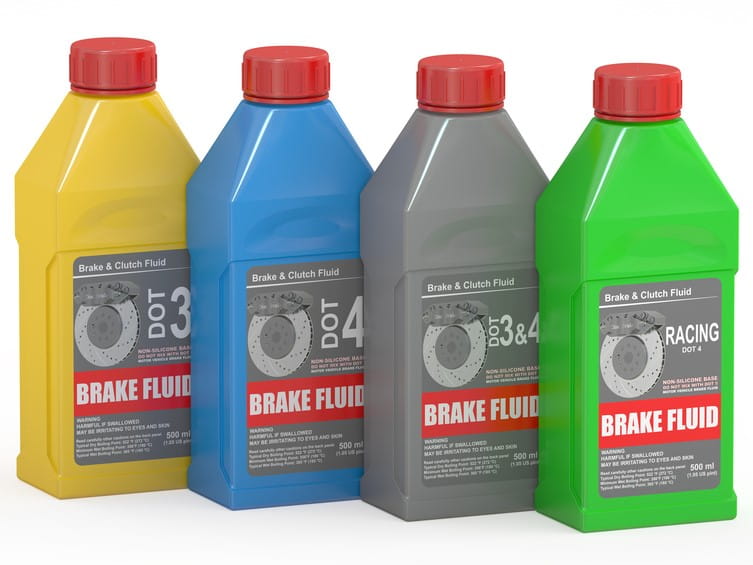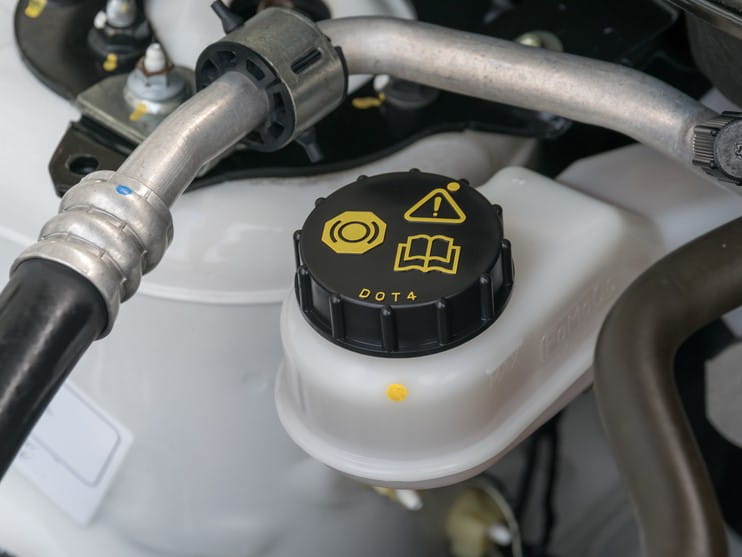Brake Fluid (diethylene glycol) A Sweet Poison

The Bottom Line
Most brake fluids contain diethylene glycol (DEG). DEG has a sweet taste making it attractive to children and pets. DEG poisoning does not produce a lot of initial symptoms but it can cause substantial kidney damage.

The Full Story
Automotive brake fluid must have a high boiling point due to the large amount of heat generated during braking. Brake fluids often contain the toxic alcohol diethylene glycol (DEG), which has a boiling point of about 470°F. Diethylene glycol (DEG) is sweet-tasting, odorless, and colorless. If swallowed, DEG can be very dangerous, even fatal, if patients do not receive prompt medical care. DEG poisoning has three characteristic phases. First, inebriation, vomiting, and changes in the body’s acid balance (acidosis). Second, the acidosis worsens and liver and kidney injury develop, which can lead to death without appropriate medical intervention. The final stage consists of delayed and sometimes fatal neurological effects including changes in the brain and spinal cord, optic nerve damage, and complete or partial muscle paralysis. Early diagnosis and treatment is essential in preventing such complications. DEG toxicity can be minimized by fomepizole – a drug stocked in hospitals.
Small children (and pets) will drink sweet-tasting brake fluid containing DEG. If recognized right away and the child receives emergency medical care, the likelihood of serious poisoning is greatly reduced.
DEG has been connected with at least 12 mass poisonings, not because of its use in brake fluid but because it was intentionally or unintentionally used in products intended for human consumption. The first documented mass poisoning was in 1937 when a pharmaceutical manufacturer introduced an elixir of sulfanilamide (an antibiotic) formulated with DEG. At least 105 people died in that incident. The Federal Food Drug and Cosmetic Act of 1938 was enacted following this tragedy to provide more consumer protection by creating and enforcing safety standards.
In 2008-2009, 57 children under the age of 3 years were poisoned with DEG in Nigeria and 54 of them died from kidney failure. Almost all of the children were known to have been given an acetaminophen-containing teething medication. DEG contamination was found in bottles of the medication from patients’ homes and in four batches of the product from the manufacturer.
In Panama in 2006, at least 78 people died from unexplained kidney failure and neurological illness. It was determined later that a cough syrup was contaminated with DEG. The syrup was manufactured using "glycerin" imported from China via a European intermediary. That "glycerin" contained approximately 22% DEG.
Currently, such large-scale poisonings from medications contaminated with DEG occur mostly in developing countries. In many cases this substitution is suspected to be economically motivated since DEG is less expensive than safe pharmaceutical-grade solvents such as glycerin. Similarly, in 1985 several Austrian wineries were found to be using diethylene glycol as a sweetener in their wines in an effort to cut costs. There was one case of kidney failure associated with drinking DEG-contaminated wine. No mass poisonings were reported, probably because the wines were tainted with small quantities of DEG.
If brake fluid is swallowed or gets in the eyes:
- If you suspect someone has swallowed brake fluid, do not make the person vomit as some of these products could cause lung injury with vomiting. Immediately check the webPOISONCONTROL® online tool for guidance or call Poison Control at 1-800-222-1222.
- When brake fluid gets in the eyes, minor irritation and redness can occur. Serious eye injury is not likely, but the eyes should be rinsed immediately. Remove contact lenses and use lots of room temperature water. For children, pour water onto the bridge of the nose and let it gently run into the eyes. Encourage blinking. After rinsing, check the webPOISONCONTROL online tool for expert guidance, or call Poison Control at 1-800-222-1222.
Mary Elizabeth May, RN, BA, MPH
Certified Specialist in Poison Information
Poisoned?
Call 1-800-222-1222 or
Prevention Tips
- Store brake fluid in its original container in a cool and well-ventilated area. Poisonings have occurred from unintentional ingestion of brake fluid stored in other containers such as soda bottles.
- Don’t store used brake fluid. Check with your local waste management or hazardous materials facility for disposal information.
- Don’t pour brake fluid down storm drains or on the ground since this can cause contamination of water or soil.
- Always store brake fluid away from children and pets; they may like the sweet taste. Spills can attract dogs and other animals.
This Really Happened
Case 1. Two adult brothers were brought to an ER 24 hours after swallowing 40 to 60 mL of brake fluid along with 80 mL of rum in an apparent suicide attempt. Both had severe vomiting and decreased urine output. Both required hemodialysis. One was dialyzed six times, the other was dialyzed eight times. Both patients developed kidney failure but had recovered well enough within a week to be discharged from the hospital.
Case 2. A 3-year-old girl drank brake fluid from a container that she found in the family car. Her parents took her to an ER. When she arrived, she was vomiting and smelled of brake fluid. The child received the antidote for DEG and other toxic alcohols in brake fluid, fomepizole, until the blood concentrations of the alcohols were negative. After 2 days in the hospital, she was fine and was sent home.
For More Information
Automotive products [internet]. Phoenix AZ: American College of Medical Toxicology [accessed Sept 2, 2016].
References
Hoyte CO, Leikin JB: Management of diethylene glycol ingestion. Clin Toxicol (Phila) 2012;50:525-7.
Sharma N, Jain S. Toxicity of brake oil. Emerg Med J 2002;19:267-8.
Poisoned?
Call 1-800-222-1222 or
Prevention Tips
- Store brake fluid in its original container in a cool and well-ventilated area. Poisonings have occurred from unintentional ingestion of brake fluid stored in other containers such as soda bottles.
- Don’t store used brake fluid. Check with your local waste management or hazardous materials facility for disposal information.
- Don’t pour brake fluid down storm drains or on the ground since this can cause contamination of water or soil.
- Always store brake fluid away from children and pets; they may like the sweet taste. Spills can attract dogs and other animals.
This Really Happened
Case 1. Two adult brothers were brought to an ER 24 hours after swallowing 40 to 60 mL of brake fluid along with 80 mL of rum in an apparent suicide attempt. Both had severe vomiting and decreased urine output. Both required hemodialysis. One was dialyzed six times, the other was dialyzed eight times. Both patients developed kidney failure but had recovered well enough within a week to be discharged from the hospital.
Case 2. A 3-year-old girl drank brake fluid from a container that she found in the family car. Her parents took her to an ER. When she arrived, she was vomiting and smelled of brake fluid. The child received the antidote for DEG and other toxic alcohols in brake fluid, fomepizole, until the blood concentrations of the alcohols were negative. After 2 days in the hospital, she was fine and was sent home.
